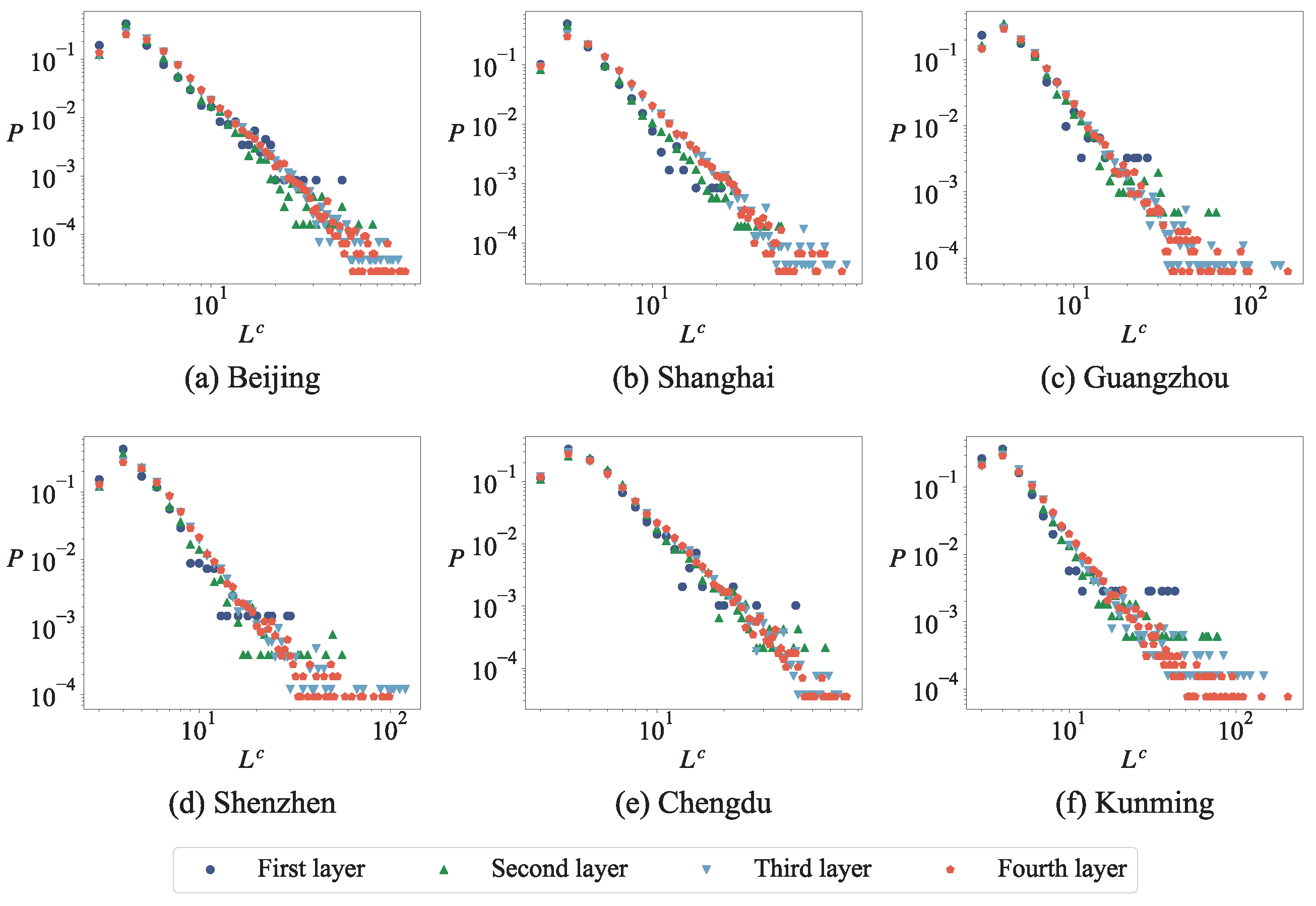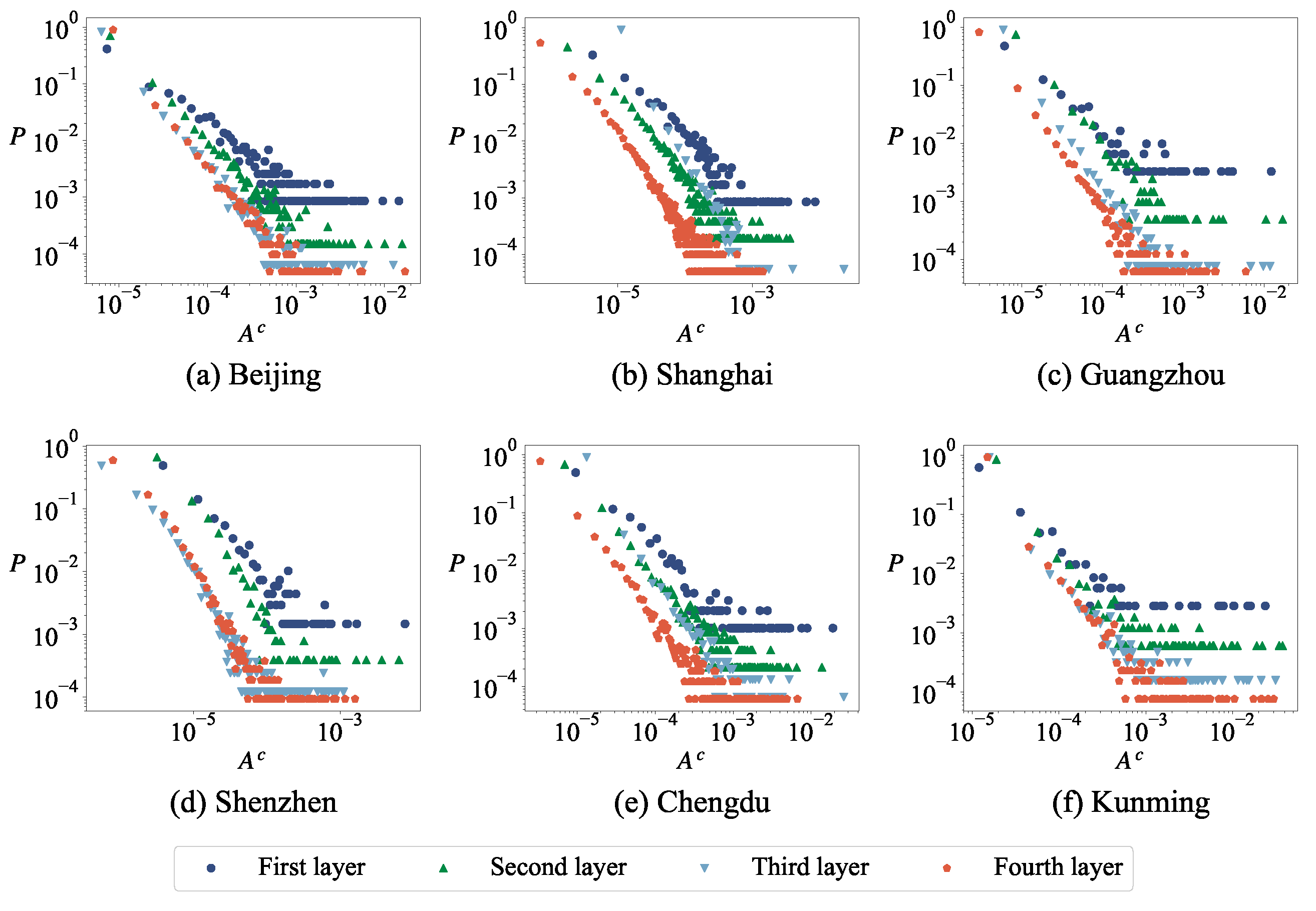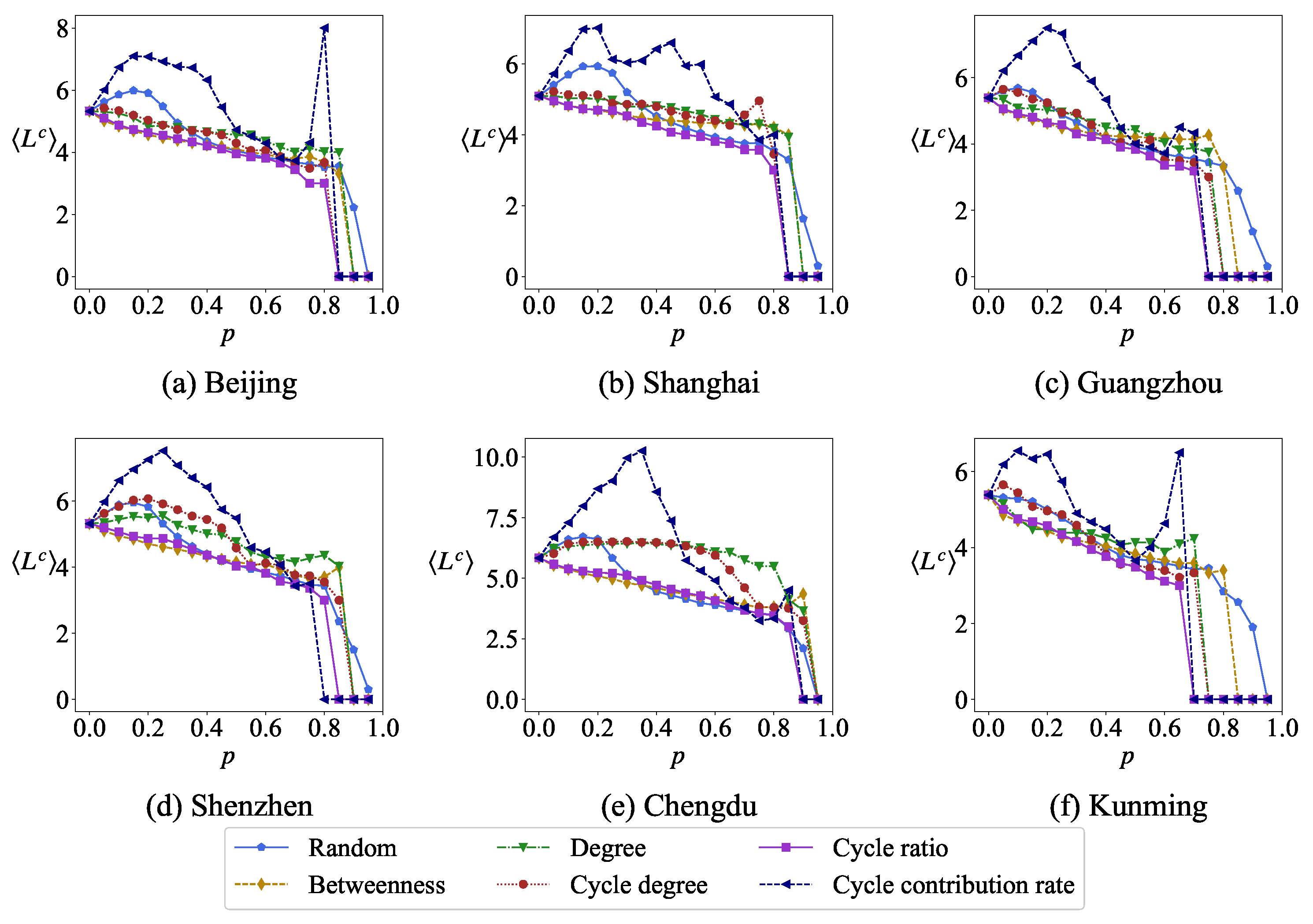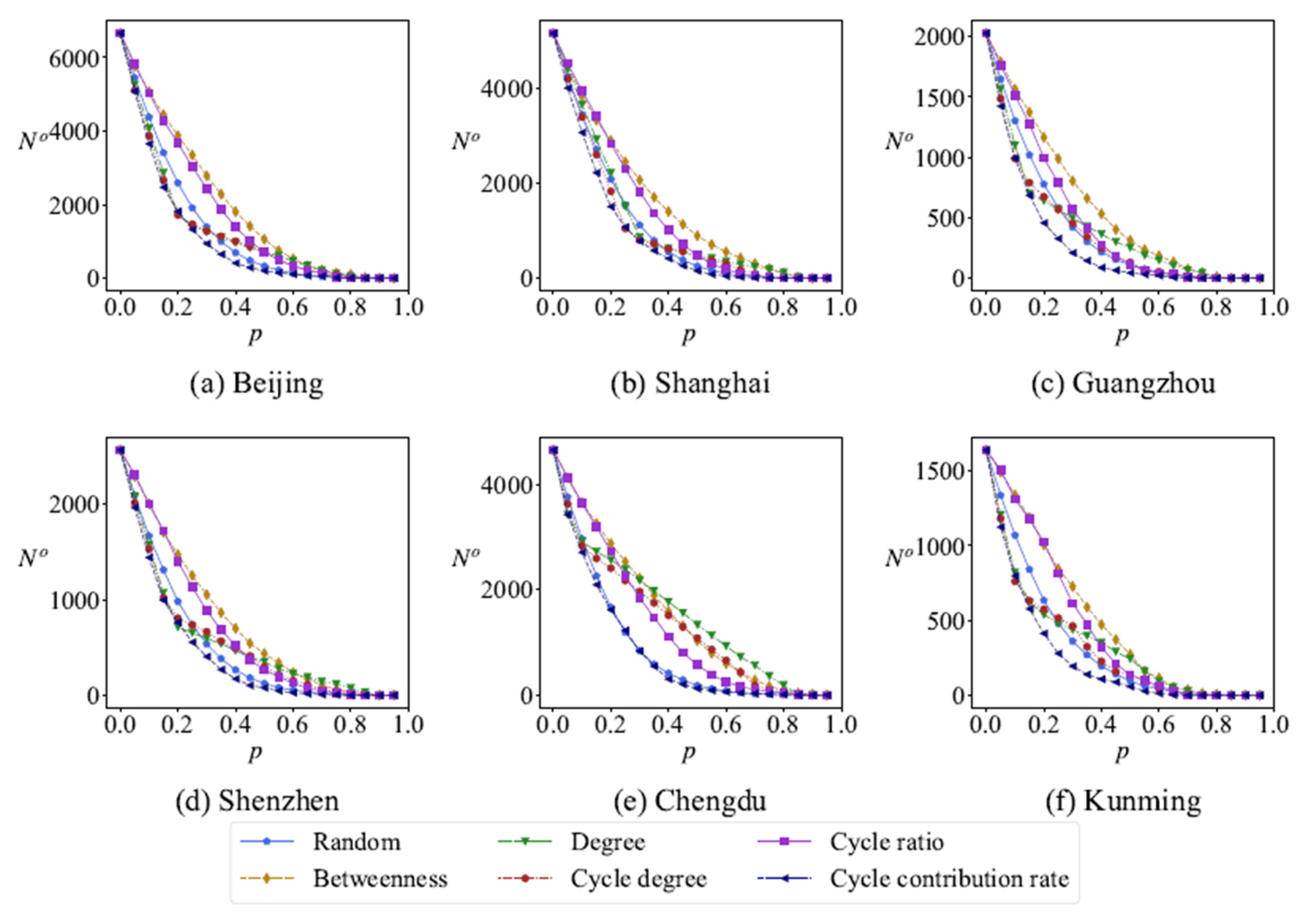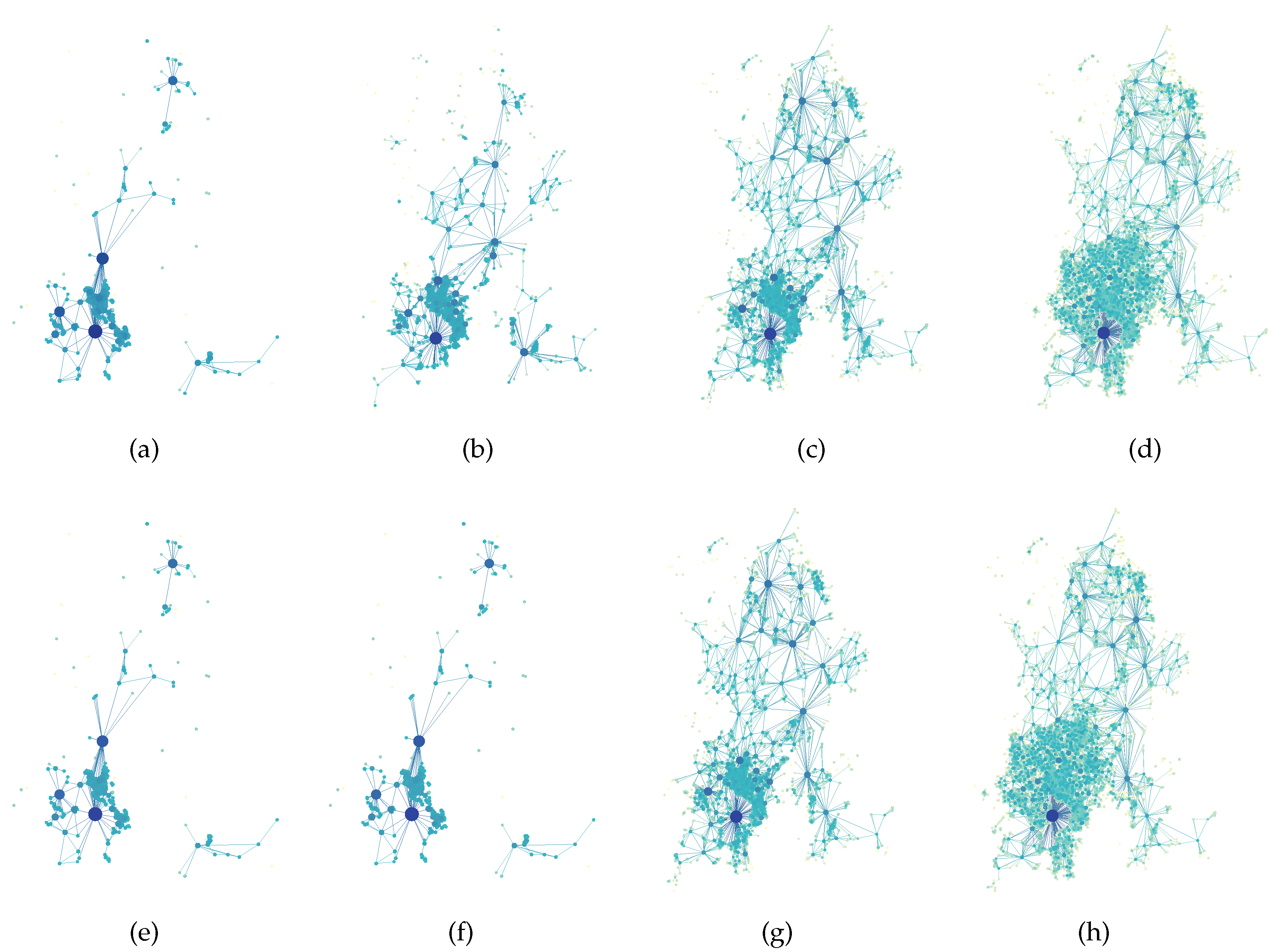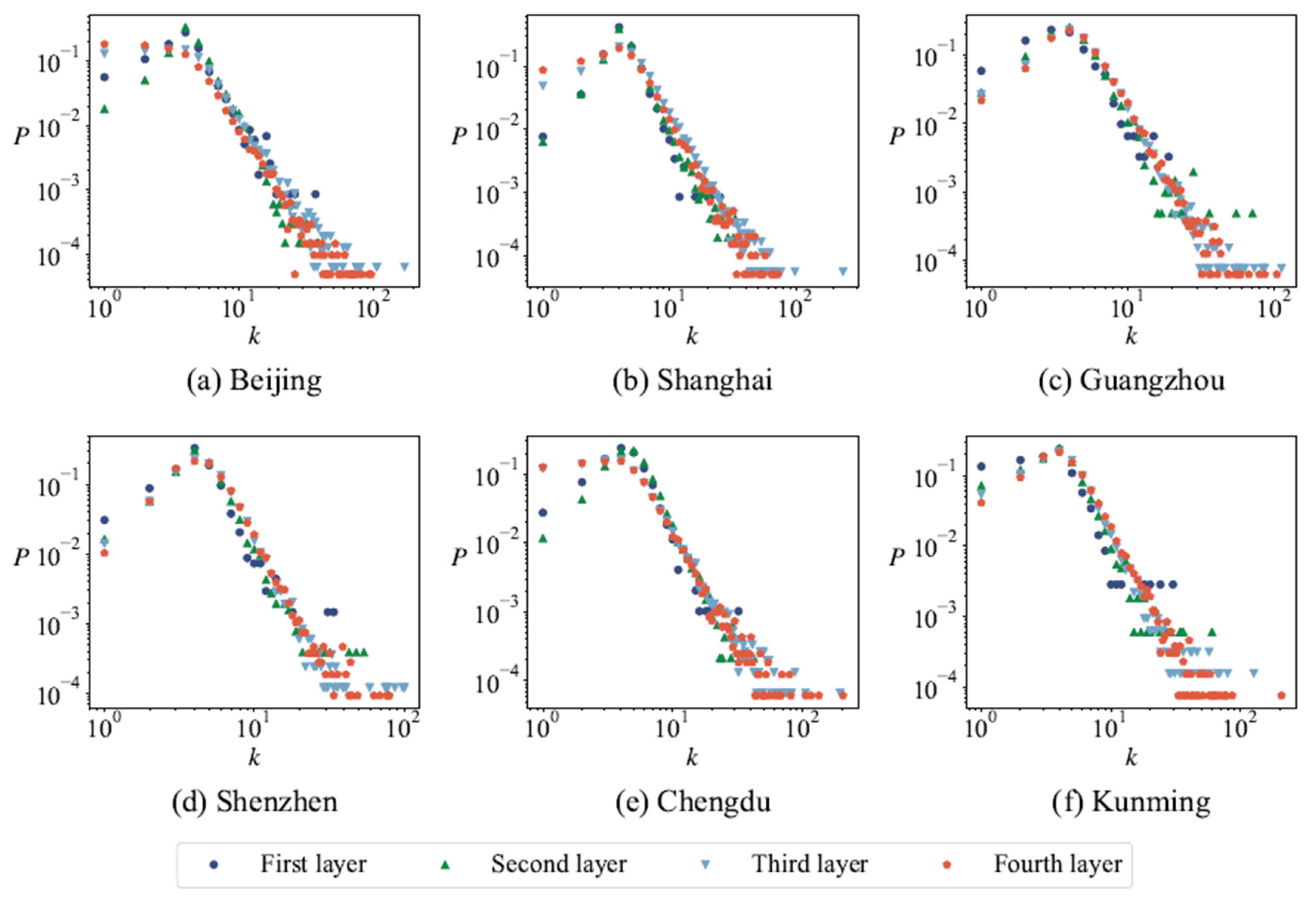1. Introduction
In recent years, researchers have embarked on a comprehensive exploration of various transportation networks, including railways [
1,
2], aviation [
3,
4], urban roads [
5,
6,
7,
8,
9,
10,
11,
12,
13,
14,
15,
16,
17], and others [
18,
19,
20]. As a vital component of a city, urban roads play an important role in the normal operation of urban functions [
21,
22]. However, with the acceleration of urbanization and the rapid surge in transportation demand, the complexity of urban road systems has increased significantly [
23,
24], and complex network theory has gained widespread acceptance in observing and analyzing this intricate structure [
25,
26,
27].
In the study of urban road networks, researchers have explored the structural characteristics of urban roads from various perspectives, including self-similarity [
5], connectivity [
6], spatial layout [
7], growth and evolution [
8], topological structure [
9,
10,
11,
12,
13], and robustness [
14,
15,
16,
17].
In terms of the node centrality and topological structure of urban road networks, researchers have conducted the following studies. Zhang et al. [
9,
10] studied the relationship between morphological features and topological characteristics, such as network degree centrality, network betweenness centrality, and network closeness centrality. Their findings revealed that betweenness centrality can effectively distinguish and describe different morphological road networks. Tsiotas et al. [
11] analyzed the relationship between urban roads and space, discovering that the degree distribution and connectivity of road networks are influenced by urban spatial constraints. Jiang et al. [
12] studied the degree characteristics of urban road networks and found a lack of degree correlation within the road networks. Shang et al. [
13] examined the topological structure of urban road networks, including clustering coefficient and average path length, and found that the small-world characteristics of urban road networks are not significant.
Regarding the resilience of urban transportation systems, the following key findings have been validated. Firstly, the adoption of different attack strategies has a significant impact on network robustness. Liu et al. [
14] studied the model of cascading failures in urban road networks, revealing that road intersections have the greatest impact on robustness. Furthermore, random attacks have a weaker impact on network robustness compared to targeted attacks. Secondly, there are differences in network robustness across different granularities. Duan et al. [
15] modeled urban road networks based on three granularities: segment-based, stroke-based, and community-based. Their results showed that due to the similarity in degree distribution and topological structure among urban road networks, robustness tends to be consistent. However, structural differences across granularities lead to variations in robustness. Thirdly, the impact of attacks targeting different topological metrics on network robustness varies. Zhao et al. [
16] employed a duality method [
17] (which abstracts road segments as nodes in the road network and converts connectivity relationships, such as intersections, into edges in the network) to transform urban road networks into topological graphs for robustness analysis. Their findings indicated that node degree has the greatest impact on robustness, followed by node betweenness and edge betweenness.
Milo et al. [
28,
29] proposed the concept of network motifs, which are small subgraphs of a network formed by a limited number of nodes arranged in a specific topological structure. In the context of road networks, motifs refer to road structural units with specific spatial configurations and traffic characteristics. These motifs appear more frequently in urban road networks than in random networks with the same degree sequence. The design and layout of these motifs directly impact the traffic flow efficiency of the road network. An optimal layout of motifs can make the road network more compact and connected, enhancing the accessibility and convenience of the city [
30].
Urban road network analysis using motif methods remains underexplored, particularly regarding Z-scores (which quantify the statistical significance of recurring substructures by comparing their observed frequency to random network expectations) with comparative analyses across motif types still lacking [
30,
31,
32]. To address this gap, we conducted a detailed analysis of urban road networks using motif methods and obtained the Z-scores for various motifs. The results revealed that motifs with cycles exhibited positive Z-scores, indicating that their frequency of occurrence was significantly higher than in random networks with the same degree sequence. In other words, cycles are ubiquitous in urban road networks, and thus they can serve as fundamental building blocks for studying urban road systems.
In the field of network analysis, the significance of cycles has garnered attention, and some exploratory research has been conducted (e.g., the distribution of cycles of different sizes in real networks and artificial networks [
33,
34,
35,
36,
37,
38,
39,
40]). Zhang et al. [
41] proposed the cycle nodes ratio (the ratio of the number of nodes belonging to cycles to the number of total nodes) for network classification. Fan et al. [
42] proposed the use of the cycle ratio (the summation of co-cycle rates among nodes sharing the same cycle with the target node) as a metric to assess the importance of nodes, comparing it with the results obtained from degree, H-index, and coreness. Experiments on real-world networks suggest that the cycle ratio contains rich information in addition to well-known benchmark indices. However, we measured the importance of nodes based on their cycle ratio in the road network. The results showed that nodes having higher cycle degrees (defined as the number of minimum cycles related to the node) within large cycles were prone to having a higher cycle ratio; however, this method could not effectively identify the central nodes in the road network. To solve this problem, we will introduce the concept of cycle contribution rate (taking into account both the quantity and length of cycles associated with each node) to assess node importance. The reason lies in the calculation differences between the cycle ratio and the cycle contribution rate. The former sums over all co-cyclic nodes in the entire network, amplifying the influence of large cycles; while the latter only accumulates contributions from directly associated cycles, emphasizing that small cycles contribute more significantly than large ones. In summary, existing network analysis methods based on cycles exhibit a lack of systematization and mathematical rigor. Notably, in graph theory, the concept of a minimum cycle basis has been proposed and applied to the analysis of small-scale networks [
43,
44,
45,
46]. For any graph, all cycles within it collectively form a cycle space. By identifying a set of linearly independent cycles within this cycle space, a minimal cycle basis can be constructed. All cycles in the network can then be expressed through this minimum cycle basis, much like how all vectors in a vector space can be represented by a set of basis vectors.
Building upon that foundation, we integrate existing cycle-related research with the theory of minimum cycle bases to develop a comprehensive methodology for road network analysis. Specifically, first, we conduct motif analysis on road networks to verify the widespread existence of cycle structures in road networks. Then, based on the minimum cycle basis, we investigate the topological characteristics (including the total number of cycles in the minimum cycle basis, the edge length distribution, and the surface area distribution of the basis, among other metrics), node centrality (including degree, cycle degree, cycle ratio and cycle contribution rate), and robustness (the relative size of the maximum connected subgraph, average cycle length in the minimal cycle basis, and total cycle count in the minimal cycle basis are measured as functions of node removal ratio under different removal strategies (degree, betweenness, cycle degree, cycle ratio, and cycle contribution rate) during progressive node removal processes) of urban road networks, respectively. Finally, we constructed two types of cycle-based dual networks by treating the minimum cycle basis as nodes and establishing connections based on the shared one node and one edge between cycles, respectively. The topological properties of the cycle-based dual network are analyzed, including degree distribution, clustering coefficient, average path length and network diameter.
The structure of this paper is arranged as follows: In
Section 2, we provide a detailed introduction to the minimum cycle basis model, robustness analysis methods, and the cycle-based dual network model. In
Section 3, we present a comprehensive analysis and further discussion of the research findings in urban road networks. Finally, in
Section 4, we summarize and draw some conclusions.
4. Conclusions
This study focuses on six cities in China(Beijing, Shanghai, Guangzhou, Shenzhen, Chengdu and Kunming) to explore the topological characteristics, the centrality of nodes and the robustness of urban road networks based on motif and the minimum cycle basis. Moreover, in order to display the hierarchical structure of urban roads and reduce the computational complexity, we select four layers of urban road networks for modeling.
Firstly, this study conducted motif analysis on six urban road networks, revealing that motifs containing cycles exhibit positive Z-scores, indicating their prevalence exceeds that of equivalent-degree sequences in random networks; based on this finding, we use the minimum cycle basis as a fundamental element for network analysis. Intriguingly, we observe that the length distribution of the minimum cycle basis in urban road networks follows a power-law distribution; To investigate node importance within urban road networks, we introduce the concept of cycle contribution rate (the importance of a node depends not only on the number of cycles it is associated with but also on the length of these cycles) and compare the results with node degree, cycle degree (the number of cycles associated with a node), and cycle ratio. The findings indicate that nodes with higher cycle degrees typically exhibit higher cycle ratios, while those associated with a greater number of smaller cycles tend to demonstrate higher cycle contributions, underscoring the advantageous role of cycle contribution in identifying central areas within road networks; subsequently, we adopted the relative size of the maximum connected subgraph, the number of cycles in the network, and the average length of cycles as observations to verify the effectiveness of cycle contribution rate in the detection of node importance and compared it with other indicators. The results reveal that with an increasing number of removed nodes, the betweenness centrality significantly impacts the relative size of the maximum connected subgraph, while the cycle ratio notably affects the average length of cycles, and the cycle contribution rate substantially influences the number of cycles; finally, we construct two types of cycle-based dual networks for urban road networks by representing cycles as nodes and establishing edges between two cycles sharing a common node and edge, respectively. The dual network exhibits small-world and scale-free properties, manifested through a power-law degree distribution, high clustering coefficients, and short average path lengths.
The adoption of the minimum cycle basis as a fundamental unit for analyzing urban road networks offers a fresh perspective for associated research endeavors, presenting the following promising applications: (1) In the process of constructing road network generation models, one may incorporate the power-law distribution characteristics of the lengths and areas associated with the minimum cycle basis; (2) by comparing the topological attributes of the minimum cycle basis across diverse cities, existing road networks can be enhanced and optimized; (3) potential applications can be explored, such as utilizing the cycle contribution rate, as introduced in this paper, to delve into the multi-centrality of networks. This metric demonstrates notable performance in both node differentiation and spatial distribution. Future endeavors may further explore related application scenarios, including community detection and link prediction grounded in the minimum cycle basis. Moreover, endeavoring to establish a comprehensive road network description and analysis framework based on the minimum cycle basis will undoubtedly aid in addressing various road-related challenges.





